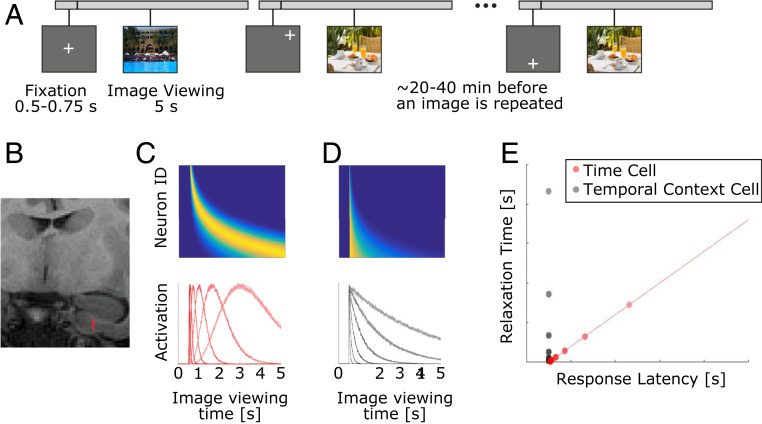Fig. 1.
(A and B) Summary of experimental procedures. (A) Trial schematic for three trials. On each trial, the monkey freely viewed an image. After the monkey viewed an image for 5 s, the image disappeared. Following every trial, the monkey performed multiple gaze calibration trials and received a fruit slurry reward (Methods has details). Images were presented twice during an experimental session. Between 20 and 40 min passed before an image was repeated. (B) Estimated position of recording channels in the EC in one recording session is shown in red on a coronal MRI. (C–E) Two hypotheses for neural representations of time. (C and D) Heat plot (Upper) and tuning curves (Lower) for two hypotheses for how a time interval of image viewing could be coded in neural populations. In the heat plots, cooler colors correspond to low activity, while warmer colors correspond to higher activity. (C) Hypothetical activity for sequentially activated time cells, like those observed in the hippocampus. In this population, different neurons exhibit peak responses at different times indicating different firing fields. Because the time of peak response across neurons covaries with the spread of the firing field, neurons with later firing fields display wider firing fields. (D) Hypothetical activity for monotonically decaying temporal context cells, like those observed in rodent EC. Neurons in this population reach their peak at about the same time. However, different neurons decay at different rates. (E) Properties of neurons representing time passage by the hypothesis shown in C (red) or the hypothesis shown in D (gray). A population of time cells (red) should exhibit responses that occur at different times across a time interval, and these neurons should show a robust correlation between when response occurs and the time it takes the response to return to baseline. Conversely, a population of exponentially decaying temporal context cells (gray) should exhibit responses that occur in a more restricted time range shortly after the start of a time interval, and these neurons should show no correlation between when peak response occurs and the time it takes to relax back to baseline.

